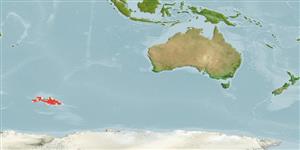Environment: milieu / climate zone / depth range / distribution range
Ökologie
seewasser bathydemersal; tiefenbereich 380 - 1010 m (Ref. 30823), usually 600 - 700 m (Ref. 11892). Deep-water; 48°S - 52°S
Southern Ocean: Kerguelen, Skif Seamount (SW of Kerguelen) and off Heard Island.
Size / Gewicht / Alter
Maturity: Lm ? range ? - ? cm
Max length : 12.6 cm TL Männchen/unbestimmt; (Ref. 44814)
Kurzbeschreibung
Morphologie | Morphometrie
Rückenflossenweichstrahlen (insgesamt): 53-58; Afterflossenweichstrahlen: 48 - 53; Wirbelzahl: 59 - 64. This species is characterized by the following: broad head; ventral and transverse mouth; smaller chin pores than mandibular pores and markedly approximated; opercular opening do not extend below 2nd and 3rd pectoral-fin rays; operculum about 1/3 HL; very large opercular lobe, extending far past of pectoral; rays of pectoral fin evenly decreasing in length without forming marked notch. Colour of peritoneum black, stomach dark brown to black (Ref. 44814).
A 1.45 cm SL fry was caught in the mesopelagic zone (Ref. 44814).
Life cycle and mating behavior
Geschlechtsreife | Fortpflanzung | Ablaichen | Eier | Fecundity | Larven
Stein, D.L. and A.P. Andriashev, 1990. Liparididae. p. 231-255. In O. Gon and P.C. Heemstra (eds.) Fishes of the Southern Ocean. J.L.B. Smith Institute of Ichthyology, Grahamstown, South Africa. (Ref. 5196)
IUCN Rote Liste Status (Ref. 130435)
Bedrohung für Menschen
Harmless
Nutzung durch Menschen
Mehr Information
NamenSynonymeMetabolismusRäuberÖkotoxikologieFortpflanzungGeschlechtsreifeAblaichenSpawning aggregationFecundityEierEientwicklung
Alter/GrößeWachstumLänge-GewichtLänge-LängeLängenhäufigkeitenMorphometrieMorphologieLarvenLarven Pop.Dyn.RekrutierungDichteBRUVS
ReferenzenAquakulturAquakultur ProfilZuchtlinienGenetikElectrophoresesVererbbarkeitKrankheitenVerarbeitungNutrientsMass conversion
PartnerBilderStamps, Coins Misc.LauteCiguateraGeschwindigkeitSchwimmstilKiemenoberflächeOtolithsGehirngrößeSehfähigkeit
Tools
Zusatzinformationen
Download XML
Internet Quellen
Estimates based on models
Preferred temperature (Ref.
123201): 1.7 - 2.9, mean 2.3 °C (based on 12 cells).
Phylogenetic diversity index (Ref.
82804): PD
50 = 0.5000 [Uniqueness, from 0.5 = low to 2.0 = high].
Bayesian length-weight: a=0.00525 (0.00237 - 0.01161), b=3.15 (2.96 - 3.34), in cm total length, based on LWR estimates for this (Sub)family-body shape (Ref.
93245).
Trophic level (Ref.
69278): 3.4 ±0.5 se; based on size and trophs of closest relatives
Widerstandsfähigkeit (Ref.
120179): mittel, Verdopplung der Population dauert 1,4 - 4,4 Jahre. (Assuming tmax>3).
Fishing Vulnerability (Ref.
59153): Low vulnerability (10 of 100).
